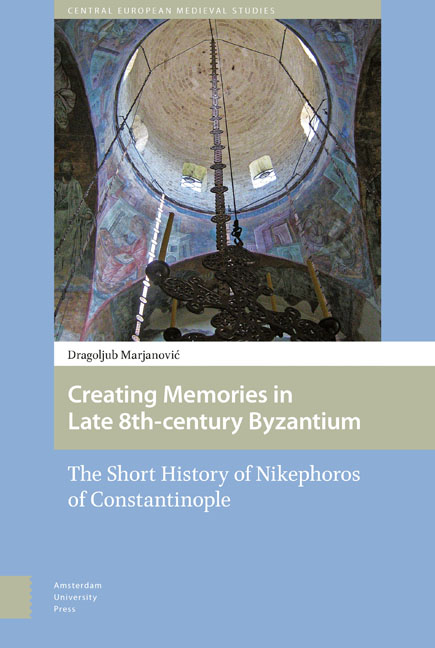Book contents
- Frontmatter
- Contents
- List of Tables
- Preface
- Introduction
- 1 Nikephoros the Layman
- 2 The Short History in the Byzantine Historiographical Tradition
- 3 Herakleios: Model of an Emperor
- 4 The Dark Century
- 5 Iconoclasts Restoring Order
- Conclusion: In Search of an Ideal Image of an Emperor
- Glossary
- Abbreviations
- Bibliography
- Index
5 - Iconoclasts Restoring Order
Published online by Cambridge University Press: 11 December 2020
- Frontmatter
- Contents
- List of Tables
- Preface
- Introduction
- 1 Nikephoros the Layman
- 2 The Short History in the Byzantine Historiographical Tradition
- 3 Herakleios: Model of an Emperor
- 4 The Dark Century
- 5 Iconoclasts Restoring Order
- Conclusion: In Search of an Ideal Image of an Emperor
- Glossary
- Abbreviations
- Bibliography
- Index
Summary
The Peace of the Emperor Leo III
The same chapter which introduced the Emperor Leo III in its narration began with a distinctive conclusion regarding the epoch that followed the reign of Justinian II, when tempestuous shifts in the imperial throne shook Byzantium. This note, interpolated by Nikephoros into this part of his work, is unique in the sense that it is the only instance of the author offering an open expression of thought, regardless whether these were his own or from his source:
On account of the frequent assumptions of imperial power and the prevalence of usurpation, the affairs of the Empire and of the City were being neglected and declined; furthermore, education was being destroyed and military organization crumbled. As a result, the enemy was able to overrun the Roman state with impunity [and to cause] much slaughter, abduction, and the capture of cities.
It is both interesting and very indicative that Theophanes, in a similar but not quite the same manner, mentioned the decline in culture and education in the Empire. However, unlike Nikephoros, who judged that such a decline was a consequence of the decrease of the state order and imperial office, Theophanes connected these events to the Emperor Leo III and his Iconoclasm, placing this narrative in the tenth year of his rule. Further, Nikephoros elaborated his conclusion by pointing to the fact that, as a result of such state of affairs, those who were enemies of the Romans (τοὺς ποƛϵμίους τῶν Ῥωμαίων) were capable of overrunning the Empire. Nikephoros here actually repeated the same motifs which were predominant in both Justinian II's rule and the rule of Philippikos Bardanes in the scenes of Bulgarian and Arab raids on Thrace and Asia Minor. Then, with more details, Nikephoros passed to the description of the main consequence of such affairs in the state of the Romans, which ultimately brought to the forefront the future Emperor Leo III. Namely, the Arabs were preparing to launch a siege of Constantinople, which was previously already mentioned in connection with the Emperor Anastasios II's defence preparations and the proper measures which he implemented to prepare the City for the coming siege.
- Type
- Chapter
- Information
- Creating Memories in Late 8th-century ByzantiumThe Short History of Nikephoros of Constantinople, pp. 169 - 230Publisher: Amsterdam University PressPrint publication year: 2017



